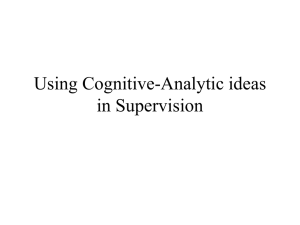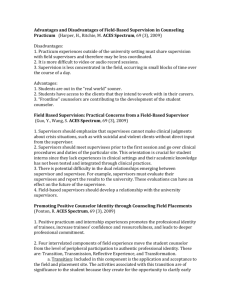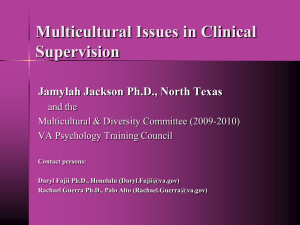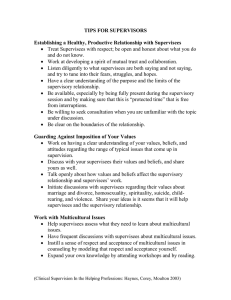Three generations of Asian counselors
advertisement
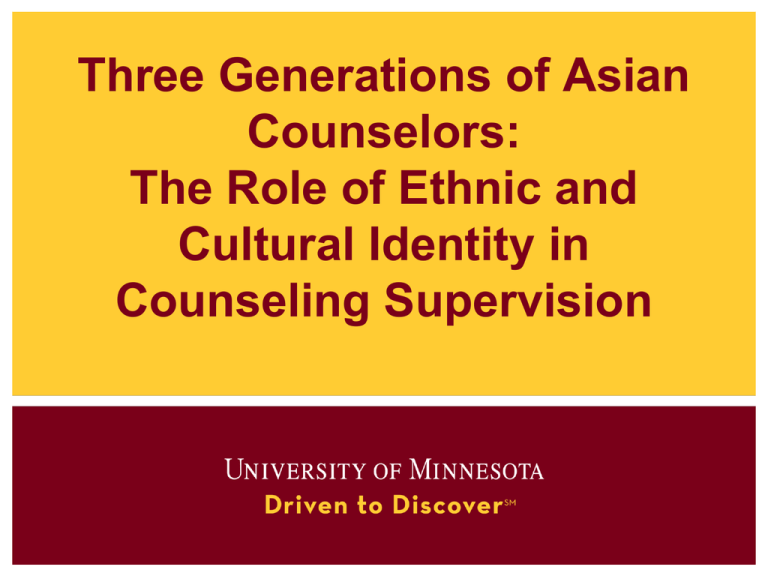
Three Generations of Asian Counselors: The Role of Ethnic and Cultural Identity in Counseling Supervision Overview • Multidimensions of cultural Identity • Introducing our own cultural identity • Supervision experiences with supervisor/supervisee who are sharing similar cultural background • Common Asian values & identity development process • Application of supervision theory • Discussion Constantine Questions • What are the main demographic variables that make up my cultural identities? • What worldviews do I bring to the supervision relationship based on these cultural identities? • What knowledge do I possess about the worldviews of supervisors/supervisees who have different cultural identities from me? • What are some of my struggles and challenges in working with supervisors/supervisees who are culturally different from me? • In what ways would I like to improve my abilities in working with culturally diverse supervisors/supervisees? Our Cultural Identities • Alison, Chinese American Immigrant Student • Ji-yeon, Korean International Female Student • Jerry, Chinese-English-American Psychologist Our Cultural Identities • Alison, Chinese American Immigrant Student • Ji-yeon, Korean International Female Student • Jerry, Chinese-English-American Psychologist Our Cultural Identities • Alison, Chinese American Immigrant Student • Ji-yeon, Korean International Female Student • Jerry, Chinese-English-American Psychologist Negative Experiences • • • • • Being “different” Being a visible minority Feeling marginalized, invisible, discounted Being stereotyped Being the victim of racial discrimination and prejudice • Shame, pain, confusion Positive Experiences • Figuring out who I am • Putting seemingly discrepant pieces together—integration • Feeling pride in my cultural heritage • Feeling connected to others with similar backgrounds • Appreciating the richness of my heritage Common Asian Values(Ho, 1992) • • • • • • • Filial piety Shame Self-control Assumption of a middle position Awareness of social milieu Fatalism Inconspicuousness Learning through Supervision • Integrating cultural identity with professional identity • Acceptance of diversity • Identifying similarities and differences • Empathic understanding • Emphasis on genuine relationship • Clarification of values, assumptions • Sharing dimensions of culture Examples • Automatic empathic understanding. “I have had the same experience.” • Sharing of experience. “Perhaps my story will help you deal with this challenge.” • Role model. “I’m glad there’s someone here who has a similar background to me.” • Counselor identity. “How can I or should I bring my identity into my counseling sessions?” Means of Interpersonal Functioning (Ancis & Ladany, 2001) • Adaptation: complacency, apathy, superficial understanding of differences • Incongruence: Confusion, some awareness, lack of commitment • Exploration: Strong emotions, e.g., anger, curiosity and insight • Integration: integrative awareness and interpersonal proficiency Supervision Relationship Types (Ancis and Ladany, 2001) • • • • Progressive Parallel-Advanced Parallel-Delayed Regressive Discussion Questions • What’s your most salient identity and how it played out in your supervisory relationship when your supervisor/supervisee was similar to yours vs. different • How cultural identity influences the development of multicultural competencies in counseling and supervision • What are some of my struggles and challenges in working with supervisors/supervisees who are culturally different from me? • In what ways would I like to improve my abilities in working with culturally diverse supervisors/supervisees? References Ancis, J., & Ladany, N. (2001). Multicultural supervision. In L. J. Bradley & N. Ladany (eds.), Counselor supervision: Principles, process, & practice (3rd ed., pp. 63-90). Philadelphia: Brunner-Routledge. Constantine, M.G. (1997). Facilitating multicultural competency in counseling supervision: Operationalizing a practical framework. In D.B. Pope-Davis & H.L.K. Coleman (eds.), Multicultural counseling competencies (pp. 310-324). Thousand Oaks, CA: Sage Publications. Ho, M.K. (1992). Minority children and adolescents in therapy. Newbury Park, CA: Sage Publications Kim, J. (1981). The process of Asian American identity development: A study of Japanese-American women’s perceptions of their struggle to achieve personal identities as Americans of Asian ancestry. Dissertation Abstracts International, 42, 1551 1A (University Microfilms No, 81-18080) Kitano, H.L., &. Maki M. T. (1996). Continuity, change, and diversity: Counseling Asian Americans. In P.B. Pedersen et al. (eds.) Counseling Across Cultures (4th ed., pp. 124–45). Thousand Oaks, CA: Sage.

